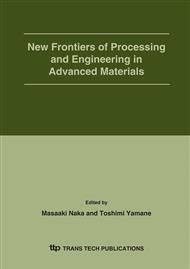p.315
p.321
p.327
p.335
p.339
p.345
p.351
p.361
p.367
In Situ Neutron Diffraction Analysis of Phase Transformation Kinetics in TRIP Steel
Abstract:
The precise characterization of the multiphase microstructure of low alloyed TRIP steels is of great importance for the interpretation and optimisation of their mechanical properties. In-situ neutron diffraction experiment was employed for monitoring of conditioned austenite transformation to ferrite, and also for retained austenite stability evaluation during subsequent mechanical loading. The progress in austenite decomposition to ferrite is monitored at different transformation temperatures. The relevant information on the course of transformation is extracted from neutron diffraction spectra. The integrated intensities of austenite and ferrite neutron diffraction profiles over the time of transformation are then assumed as a measure of the volume fractions of both phases in dependence on transformation temperature. Useful information was also obtained on retained austenite stability in TRIP steel during mechanical testing. The in-situ neutron diffraction experiments were conducted at two different diffractometers to assess the reliability of neutron diffraction technique in monitoring the transformation of retained austenite during room temperature tensile test. In both experiments the neutron investigation was focused on the volume fraction quantification of retained austenite as well as on internal stresses rising in structure phases due to retained austenite transformation.
Info:
Periodical:
Pages:
339-344
Citation:
Online since:
December 2005
Authors:
Price:
Сopyright:
© 2005 Trans Tech Publications Ltd. All Rights Reserved
Share:
Citation:


